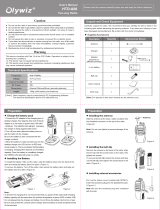DTMF
The dealer can set DTMF signaling into encoding sequence. If DTMF is set in the encoding
tem
plate, press the corresponding programmable button “Call 1” , “Call 2”, “Call 3”, or “Call
4”to transmit the coding.
5-Tone Signaling
The dealer can activate or inactivate this function by programming.
5-Tone has 9 encoding formats: CCIR1, CCIR2, ZVEI1, ZVEI2, SVEI3, EEA, EIA, USER
DEFINE
D 1, and USER DEFINED 2. The last tow formats are user defined.
1) 5-Tone Decoding
The decoding template is 5-tone decoding. If the decoding template matches the encoding
tem
plate, decoding succeeds.
When receiving proper 5-tone signaling, squelch will be activated according to the “RX Squelch
Mod
e” defined by the user. You can receive the call and LED flashes orange.
After the radio decoding succeeds, the radio will work according to the decoding call response set
by the
dealer.
2) 5-Tone Encoding
Encoding template consists of at least one and at most three encoding sequences, and each
dec
oding sequence can be set with 5-Tone, and DTMF. If it is set with 5-Tone, you need to
program its content.
If the PTT ID on the channel you select has been set with 5-Tone, 5-Tone signaling will be
transm
itted when making a call.
Or transmit 5-Tone signal by pressing the Call 1/2/3/4 button,, which can be set by the dealer.
2-Tone Signaling
This function can be enabled or disabled by dealers through programming software.
2Tone has 4 systems; the single tone continuous time, such as firsttone or second tone, could be
set by
the dealer.
1) 2Tone decode
If the received 2 tone is same as the template chose
n then it can decode successfully. After the
radio received the correct 2 tone signaling, according to the Receive squelch mode set by the user,
the squelch will be ON. Then, the radio can receive the call and the orange LED light flashes.
After decoding successfully, the radio can work according to the decode call response set by the
dea
ler.
2) 2Tone encode
The encoding template is set in the 2 tone call list. The details must be set if encoding is ON. The
radio
transmits the 2 tone signaling when the programmed call button is pressed. (The side button
could be programmed as Call1/2/3/4). This function is programmed by the dealer.
MDC Signaling
This function can be enabled or disabled by the dealers through programming software.
MDC has 4 systems, in which different main ID, group ID, etc.could be set by the dealer.
1) MDC decode
18




















